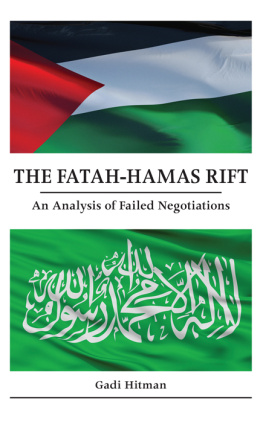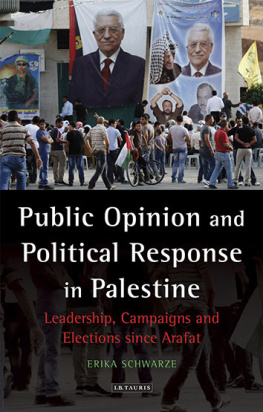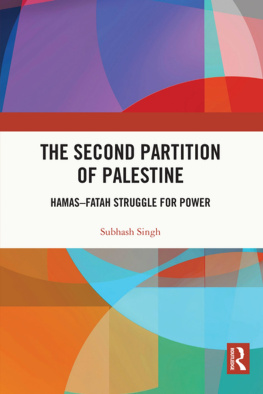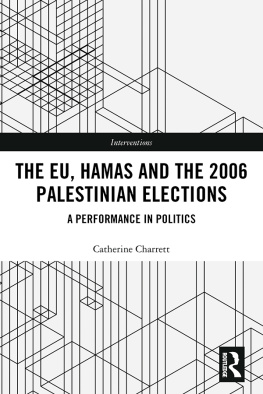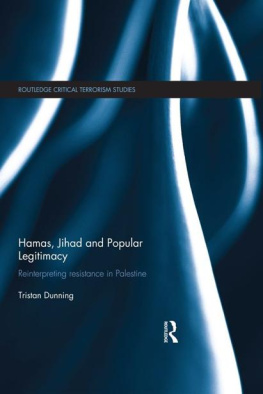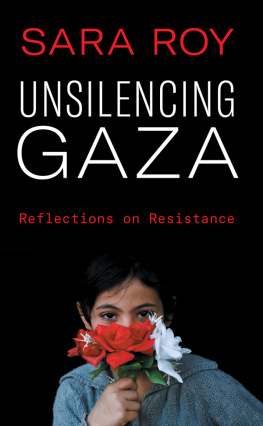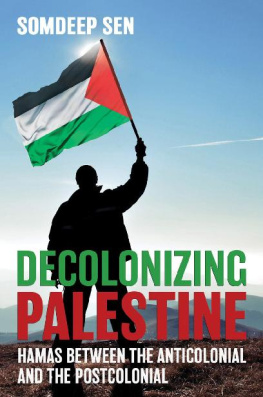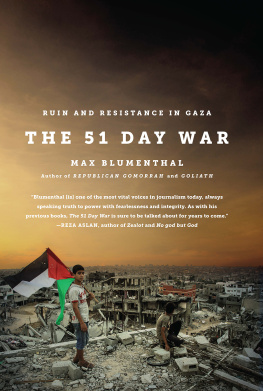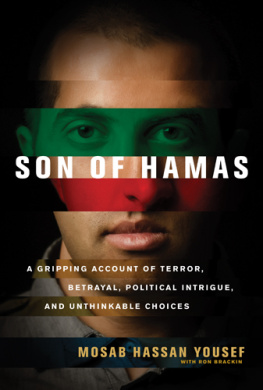Stanford Studies in Middle Eastern and Islamic Societies and Cultures
TAREQ BACONI
HAMAS CONTAINED
THE RISE AND PACIFICATION OF PALESTINIAN RESISTANCE
STANFORD UNIVERSITY PRESS
STANFORD, CALIFORNIA
Stanford University Press
Stanford, California
2018 by the Board of Trustees of the Leland Stanford Junior University.
All rights reserved.
No part of this book may be reproduced or transmitted in any form or by any means, electronic or mechanical, including photocopying and recording, or in any information storage or retrieval system without the prior written permission of Stanford University Press.
Printed in the United States of America on acid-free, archival-quality paper
Library of Congress Cataloging-in-Publication Data
Names: Baconi, Tareq, author.
Title: Hamas contained : the rise and pacification of Palestinian resistance / Tareq Baconi.
Description: Stanford, California : Stanford University Press, 2018. | Series: Stanford studies in Middle Eastern and Islamic societies and cultures | Includes bibliographical references and index.
Identifiers: LCCN 2017050720 (print) | LCCN 2017053020 (ebook) | ISBN 9781503605817 (e-book) | ISBN 9780804797412 (cloth : alk. paper) |
Subjects: LCSH: arakat al-Muqwamah al-IslmyahHistory. | Palestinian ArabsPolitics and government. | PalestinePolitics and government1948 | Gaza StripPolitics and government. | Arab-Israeli conflict.
Classification: LCC DS119.7 (ebook) | LCC DS119.7 .B173 2018 (print) | DDC 324.25694/2083dc23
LC record available at https://lccn.loc.gov/2017050720
Cover design: Matt Tanner
Cover photo: Tareq Baconi
Typeset by Bruce Lundquist in 11/16 Baskerville
To Eva
CONTENTS
PREFACE
While finishing this book, I attended a performance of Les Blancs (The Whites) in Londons National Theatre. This was the last play written by Lorraine Hansberry, the celebrated African American writer and playwright known for her work on identity and race relations in the United States. Les Blancs is her only play set in Africa. It recounts the story of an African man who travels from Europe, where he lives with his child and white wife, back to his unnamed birthplace to attend his fathers funeral. The anticolonial struggle his father had started there has gained ground, and the nation is on the brink of revolution. Hansberrys protagonist, imbued with European values and the sheen of London civility, is a firm believer in nonviolent protest. He is also a proud and confident man, bristling at the condescension of colonial masters.
Dueling emotions wash over our protagonist as he tries to straddle two worlds and reconcile his dedication to nonviolence with the urgent struggle on the ground. Political discussions in the powerhouse of colonial Europe appear futile and out of touch. Peaceful protest feels wholly inadequate as the protagonists countrymen and women are slaughtered around him by colonial rifles. Dissonant themes collide, from the incivility and barbarity of armed struggle to the ignorance of the native in refusing European modernity. Questions of identity, violence, race, and nationalism test deeply held convictions, values, and beliefs. Over the course of a few hours, painstakingly crafted worldviews unravel in slow and excruciating ways. Minutes before the curtain falls, the protagonist reaches for his knife, slaughtering his first victim. It is his brother, a priest who had joined a European mission to convert fellow Africans to the Christian faith. With this final act of brutal fratricide, the illusion of peaceful decolonization appears to have been shattered.
Hansberrys eloquent and sophisticated play was unflinching in its depiction of the complex moral ambiguity inherent in the adoption of arms for the pursuit of freedom. I was mesmerized. My companions thought it simplistic and unoriginal. There was nothing innovative, in their view, about contending with the brutality of liberation struggles. A twenty-first-century London audience, it seemed, could grapple with the role of violence in the face of colonial rule. This was understood as a natural and desperate fight for dignity. It was reductionist to conflate anticolonial violence with native barbarism.
Sitting in the darkness of the theater, I thought of Palestine. Lacking the clarity of historical hindsight, the Palestinian struggle for self-determination seems frozen in time, in many ways an interminable anticolonial struggle unfolding in a postcolonial world. It is a world that has confronted the carnage of decolonization. But the battle is still raging in Palestine, with ever-present urgency. The simplistic binaries that frame conversations of Palestinian armed struggle evoke the condescension expressed by colonial overlords toward the resistance of indigenous peoples. Palestinians have a culture of hate, commentators blast on American TV screens. They are a people who celebrate death. These familiar accusations, quick to roll off tongues, are both highly effective at framing public discourse and insulting as racist epithets. On the other end of the spectrum, I recalled conversations with Europeans and Palestinians who critiqued my reference to Palestinian armed struggle as violence. They saw this framing as a form of condemnation, casting armed struggle in a negative light. Support of the rifle, they argued, was not only comprehensible and dignified, but necessary. It was the only way to secure Palestinian rights against a murderous and unrelenting occupation.
As the play ended, I reflected on the history of violence in the Palestinian struggle, the advances it secured and the tragedy it sowed. I This condemnation was demanded as a prerequisite for the right of these analysts to engage in any debate about the events on the ground. There was no other explanation, it seemed, for the loss of life in Gaza and Israel other than pure-and-simple Palestinian hatred and bloodlust, embodied by Hamas. I wondered how many lives, both Palestinian and Israeli, have been lost or marred by this refusal to engage with the drivers of Palestinian resistance, of which Hamas is only one facet. I considered the elision of the broader historical and political context of the Palestinian struggle in most conversations regarding Hamas. Whether condemnation or support, it felt to me, many of the views I faced on Palestinian armed resistance were unburdened by moral angst or ambiguity. There was often a certainty or a conviction about resistance that was too easily forthcoming.
I have struggled to find such certainty in my own study of Hamas, even as I remain unwavering in my condemnation of targeting civilians, on either side. For close to a decade, I have attempted to peel back all the layers that have given rise to the present dynamic of vilifying and isolating Hamas, and with it, of making acceptable the demonization and suffering of millions of Palestinians within the Gaza Strip. The product is this book, which seeks to explore Hamass world order and present the voice of a marginalized group that remains central to the Palestinian national movement. This book works to advance our knowledge of Hamas by elucidating the manner in which the movement evolved over the course of its three decades in existence, from 1987 onward. Understanding Hamas is key to ending the denial of Palestinians their rights after nearly a century of struggle for self-determination.
It is also a prerequisite to halting the cycles of violence that are intermittently unleashed on the inhabitants of the Gaza Strip. Nearly one year before that evening at the National Theatre, I was talking to a young boy in Gaza. The conversation was during the Islamic month of Ramadan in 2015, and everyone was sluggish from the June heat. I asked him about the school year he had just finished and whether he was happy to be on holiday. He shrugged. Sixth grade was fine, he said, a bit odd. He was in Grade A and he used to look forward to playing football against Grade B. That past year, though, the school administration had merged several grades together. The classes were crowded and the football games less enjoyable. I wondered aloud to the boy why the school administration had done that. Annoyed that I was not engaging with the issue at hand, that of football politics, he answered in an exasperated tone. Half of the Grade A kids had been martyred the summer before, he snapped. The kids who had survived no longer filled an entire classroom.
Next page

